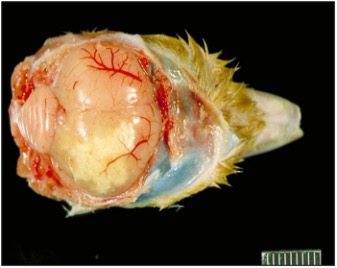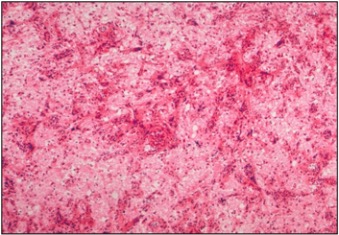Ochroconosis (Dactylariosis) in birds
Martin Ficken, DVM
Ochroconosis is a sporadic fungal encephalitis that has been reported in young chickens, turkey poults, quail chicks, and wild birds. It is caused by a dematiaceous, thermophilic fungus, Ochroconis gallopava (Dactylaris gallopava). O. gallopava is a ubiquitous fungus found in hot spring environments, soil, wood, and decaying vegetation. In birds, ochroconosis has been associated with contaminated litter and egg incubators and is presumed to be contracted from inhaling fungal spores from the contaminated environment.1
Clinical signs involve the central nervous system and include tremors, incoordination, torticollis, and paralysis. Death often occurs after a short clinical course. Gross lesions are described as focally extensive circumscribed firm areas of discoloration (gray, red, cream-colored) in the cerebrum and/or cerebellum (Figure 1). In some cases, pulmonary granulomas may also be present. Microscopically, lesions consist of multifocal areas of necrosis infiltrated by heterophils, macrophages, and multinucleated giant cells. Pigmented hyphae are apparent on H&E-stained sections as yellow to light brown, septate, irregularly-branched and 1.2 – 2.4 microns in diameter (Figure 2).
A presumptive diagnosis can be made on histopathological lesions and characteristic pigmented hyphae within the inflammatory lesions. Definitive diagnosis is done by isolation and identification of the organism.2 When the disease occurs, removal of the contaminated litter and/or decontamination of incubators and hatchers by fumigation is recommended.
For more information about poultry testing, contact one of TVMDL’s poultry laboratories in Gonzales or Center. To learn more about TVMDL’s testing options, visit tvmdl.tamu.edu or call 1.888.646.5623.

Figure 1 – Turkey poult with cerebral ochroconosis. Notice cream-colored discoloration in right cerebral hemisphere. Photograph courtesy of Dr. H. John Barnes, College of Veterinary Medicine, North Carolina State University.

Figure 2 – Turkey poult with cerebral ochroconosis. Notice dark-colored fungal fragments. Photograph courtesy of Dr. H. John Barnes, College of Veterinary Medicine, North Carolina State University.
References
- Dykstra MJ, Charlton BR, Chin RP, and Barnes HJ. Fungal Infections in Diseases of Poultry, 13th edition, Wiley-Blackwell, ed. Swayne, DE et al. pp. 1091-1092, 2013.
- Gold SE, Glenn AE, and Wyatt RD. Dactylaria in A Laboratory Manual for the Isolation, Identification, and Characterization of Avian Pathogens, 6th Edition, page 75, 2016.